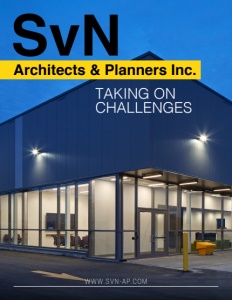SvN Architects & Planners Inc.
Taking on challenges
Business View Magazine interviews representatives from SvN Architects & Planners Inc., as part of our focus on best practices in urban design.
SvN Architects & Planners Inc. (SvN) is a team of architects, landscape architects, planners, and urban designers based in Toronto, Ontario. The company, originally founded in 1978 by its founding principal, John Van Nostrand, has gone through various iterations over the past four decades. The latest of these centers on the re-branding of planningAlliance and regionalArchitects to form SvN in 2015. For over 40 years, the company, and now its staff of 55, has been responsible for shaping the built environment of regions, cities, and towns across Canada and around the world. They have revitalized industrial waterfronts, developed new and alternative forms of housing, designed resilient neighborhoods, and promoted the economic development of both rural and urban regions.
SvN engages with the dynamic social, economic, and environmental forces that define and govern the places where people live, work and play. This involves studying local histories, anticipating emerging economies, identifying social and environmental risks and opportunities, and planning and designing in response to rapid growth and change. The company works in partnership with public and private-sector clients, and a variety of stakeholders, to create visionary ideas, and find ways to render them viable. Its plans, designs, and strategies for housing, mixed-use communities, schools, churches, community-based institutions, and public spaces are both particular and flexible. They respond to the specific needs of people and their environments, but are designed to adapt and change in response to new conditions as they arise.

“We have a mix of clients,” says Business Development Director, Blair Scorgie. “On the architecture side, we primarily work with private land developers and not-for-profit agencies. These include affordable housing providers, such as the Toronto Community Housing Corporation. The breadth of work is significant. SvN are market leaders in housing and mobility. On the mobility side, SvN believes that transit corridors and mobility hubs should be treated with the same kind of design thinking and intelligence as great municipal theatres, public parks, and grand boulevards. Much of our work centers on the planning and design of station areas, transit corridors, and transit-oriented private land development. On the housing side, SvN offers thought leadership on how housing is designed, built, consumed and owned. Much of our work centers on alternative forms of housing, including purpose-built rental housing, seniors housing, student housing, co-housing, and multi-generational housing. However, we also undertake work within the commercial, institutional, and medical pharmaceutical sectors.”
“On the urban design side, we’re split,” Scorgie continues. “Much of our work is secured through a competitive bidding process with public sector agencies, including lower-tier municipal governments (e.g. City of Toronto) and the provincial government (e.g. Metrolinx and Infrastructure Ontario). We also work with academic and cultural institutions. However, we also work with private land developers and real estate investment trusts.
“On the planning side, we offer a range of services including development approvals for private land developers, and land use and policy planning studies for lower-tier municipal governments. Because SvN works with public-sector agencies, we are uniquely positioned to serve private developers who value this knowledge. Our unique understanding of the market allows us to maximize public and private investments, and unlock the development potential of underutilized sites.”
Scorgie adds that all three divisions of the company – planning, urban design, and architecture – work together on transit-oriented development projects. “Recently, we have negotiated complex agreements between multiple stakeholders, including provincial government authorities, municipal governments, and private land developers to integrate development with new transit infrastructure.”
It is that combination of expertise that Scorgie believes gives SvN a competitive advantage. “We’re a truly integrated, multi-disciplinary planning and design practice,” he states. “We collaborate inter-departmentally on quite few different projects, even for services which would typically be provided by a single discipline. For example, when our planning team is assisting a developer with their due diligence process, we bring in members of our urban design and architecture teams to advise on certain design matters, upfront (e.g. parking, loading, and amenity space configurations), for the sake of improving efficiency, minimizing risk, and creating greater certainty down the road. It helps us anticipate issues early on, creating a more defensible approach to master planning.
“The multi-disciplinary nature of our company also allows us to undertake a greater breadth of work, beyond what many of our competitors are able to offer. There is efficiency, in terms of time, financing, and coordination, in having all these services offered together. It is one of our main competitive advantages.
“We come from a very strong social mandate, and we apply that lens to all of our work. We also tend to engage in complex projects with unique conditions. We operate in areas where there are no ready-made solutions. This includes areas where the policy and regulatory framework is unclear or has not been properly defined; a new or emerging building typology, which is without local precedent; unique construction technologies; or innovative ways to address housing affordability issues. So, we take a different approach in the planning and design process.
“We also bring together different parties into what might otherwise be considered unlikely alliances. We help stakeholders find the benefit in working together to achieve common or overlapping objectives, where they may not otherwise be realized, and to help them identify a path forward to achieving those objectives. A recent example of that: we worked with the City of Toronto, Metrolinx and a landowner to negotiate the redevelopment of Mimico GO Station. That process was about leveraging the opportunity of partnering in order to help finance transit infrastructure, achieve desirable public benefits and, in the process, realize additional development potential.”

Company Principal, Sony Rai, agrees. “It’s that overlapping of work between the private and public sector and understanding each of their needs and demands,” he proffers. “We’re able to bring a perspective that is appreciated by both clients.”
Recently, the company has been working with new entrants into the emerging cannabis industry in Canada. “Our involvement with the industry began with planning work for Med Relief about three years ago,” Rai recounts. “They were our first client within the sector. They came to us because they were looking to purchase certain properties in different jurisdictions and they wanted to understand what the approvals process was to be able to build the types of facilities they were thinking about. That was our first foray into understanding the beginning of that industry – through the municipal and approvals lens and larger scale development. It was new both for us and for the municipalities we were dealing with.
“Then, we connected with the Cronos Group – they were looking to buy what was known as the Peace Naturals project, their property in Stayner, Ontario. Prior to them finalizing the purchase, they wanted us to take a look at both the existing facilities that were there on the property, the existing planning framework that was in place, and all the outstanding building permits, to get a broad understanding of the risks involved in purchasing the property. So, we did a high-level study for them, initially. That led to some smaller-scale retrofit work of their existing facilities, which then led to the work that we’ve recently completed, which was their 280,000-sq.-ft. facility.”
“We have also been involved with a group called MedMen, based out of California that is expanding into the Canadian market,” Scorgie adds. “They are looking at the Alberta and British Columbia markets, with an interest is in setting up commercial storefronts. On the planning side, we have been engaged to assist with their due diligence. We worked with them to identify a short list of potential sites for their operations, which involved compliance report letters and what we call ‘radii mapping.’ The process involves a high-level review of the policy and regulatory framework, both at the provincial and the municipal levels. A lot of the policies and regulations, both in Alberta and British Columbia, center around separation distances between commercial cannabis storefronts and what are perceived to be ‘sensitive uses’– schools, childcare facilities, community centers, etc. It can be quite challenging to pinpoint a location that meets all the criteria.
“The first step is to determine if the site meets the intent of the policy framework with respect to the use of the land. Then we proceed to a secondary stage of analysis, where we look at the proximity of these locations to sensitive uses, as well as their competitors. In both Alberta and British Columbia, there are a lot of unlicensed retail establishments. So, it becomes a matter of identifying which have submitted applications to receive licenses, and which haven’t.”
Another sector that SvN has gotten involved with, recently, is that of real estate investment trusts that own large swaths of commercial land in and around Toronto. “These are companies that, traditionally, would operate in enclosed mall structures or open air strip malls,” Scorgie notes. “We’re working with these clients to realize the untapped development potential of these sites. Many are located within the inner suburbs, near major intersections, are relatively accessible by transit and are in close proximity to neighborhood amenities. These sites represent some of the last, real, large-scale opportunities for urban intensification. The suburbs are being transformed in large part by the redevelopment of these sites, and their location lends well to this type of redevelopment.
“We are working with some of these real estate investment trusts to transform these sites into vibrant and diverse communities that are transit-supportive. In doing so, we are incorporating a variety and mix of uses. Often, the process includes replacing existing commercial buildings with new office, retail, residential, and institutional uses, including libraries, community centers, and in one case, a post-secondary academic institution. It also involves the introduction of new and expanded parks and open spaces, and a variety of housing types and tenureships.”
Rai sums up operating ethos of this multi-faceted, company: “Our unique mix of planning, architecture, and urban design enables us to take on these large-scale, complex projects that have an impact beyond a single building,” he states. “Typically, they’re very transformative projects such as the reimagining and redeveloping of a traditional suburban shopping mall. We’re an office that’s focused on challenging work both in scale and complexity of uses.”
*All photos provided courtesy of Ben Rahn / A-Frame
AT A GLANCE
WHO: SvN Architects & Planners Inc.
WHAT: A team of architects, planners, and urban designers
WHERE: Toronto, Ontario
WEBSITE: www.svn-ap.com
PREFERRED VENDORS
Wallwin Integrated Systems – www.wallwinintegratedsystems.com
Wallwin Integrated Systems is a Security contractor with experience in Cannabis facility projects ranging from 10,000 SqFt to 700,000 SqFt. Their expertise in Design, Regulation Compliance, Installation and maintenance of Cannabis facility’s intrusion detection, access control and surveillance systems, has earned the trust from licensed producers all across Canada.




